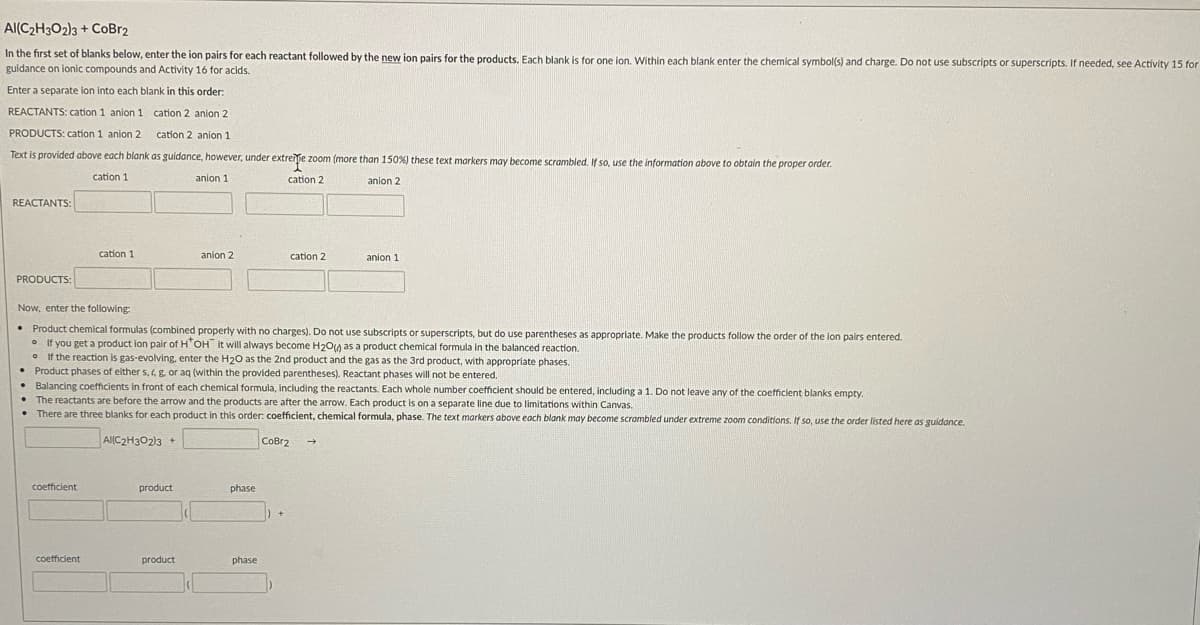Al(C2H3O2)3 + CoBr2 In the first set of blanks below, enter the ion pairs for each reactant followed by the new ion pairs for the products. Each blank is for one ion. Within each blank enter the chemical symbol(s) and charge. Do not use subscripts or superscripts. If needed, see Activity 15 fom guidance on ionic compounds and Activity 16 for acids. Enter a separate ion into each blank in this order: REACTANTS: cation 1 anion 1 cation 2 anion 2 PRODUCTS: cation 1 anion 2 cation 2 anion 1 Text is provided above each blank as guidance, however, under extreite zoom (more than 150%) these text markers may become scrambled. If so, use the information above to obtain the proper order. cation 1 anion 1 cation 2 anion 2 REACTANTS: cation 1 anion 2 cation 2 anion 1 PRODUCTS: Now, enter the following • Product chemical formulas (combined properly with no charges). Do not use subscripts or superscripts, but do use parentheses as appropriate. Make the products follow the order of the ion pairs entered. O If you get a product ion pair of H'OH it will always become H2014 as a product chemical formula in the balanced reaction. • If the reaction is gas-evolving, enter the H20 as the 2nd product and the gas as the 3rd product, with appropriate phases. • Product phases of either s, 4g or aq (within the provided parentheses). Reactant phases will not be entered. Balancing coefficients in front of each chemical formula, including the reactants. Each whole number coefficient should be entered, including a 1. Do not leave any of the coefficient blanks empty. The reactants are before the arrow and the products are after the arrow. Each product is on a separate line due to limitations within Canvas. • There are three blanks for each product in this order: coefficient, chemical formula, phase. The text markers above each blank may become scrambled under extreme zoom conditions, If so, use the order listed here as guidance. AllC2H302)3 + COBr2 coefficient product phase coefficient product phase
Formal Charges
Formal charges have an important role in organic chemistry since this concept helps us to know whether an atom in a molecule is neutral/bears a positive or negative charge. Even if some molecules are neutral, the atoms within that molecule need not be neutral atoms.
Polarity Of Water
In simple chemical terms, polarity refers to the separation of charges in a chemical species leading into formation of two polar ends which are positively charged end and negatively charged end. Polarity in any molecule occurs due to the differences in the electronegativities of the bonded atoms. Water, as we all know has two hydrogen atoms bonded to an oxygen atom. As oxygen is more electronegative than hydrogen thus, there exists polarity in the bonds which is why water is known as a polar solvent.
Valence Bond Theory Vbt
Valence bond theory (VBT) in simple terms explains how individual atomic orbitals with an unpaired electron each, come close to each other and overlap to form a molecular orbital giving a covalent bond. It gives a quantum mechanical approach to the formation of covalent bonds with the help of wavefunctions using attractive and repulsive energies when two atoms are brought from infinity to their internuclear distance.

Trending now
This is a popular solution!
Step by step
Solved in 3 steps









